Abstract
Human peripheral blood leucocytes, cultured for 4--6 days with the appropriate concentration of protein or synthetic polypeptide antigen, yield helper cells. These cells, after a further 24 hr incubation with the appropriate antigen release helper factors, which are of two types, antigen specific and non-specific; a similar situation to that described in the mouse. These factors are assayed by their effects on the plaque-forming cell response of mouse spleen cells cultures in vitro. The potential applications of this new assay for human T cell function are discussed.
Full text
PDF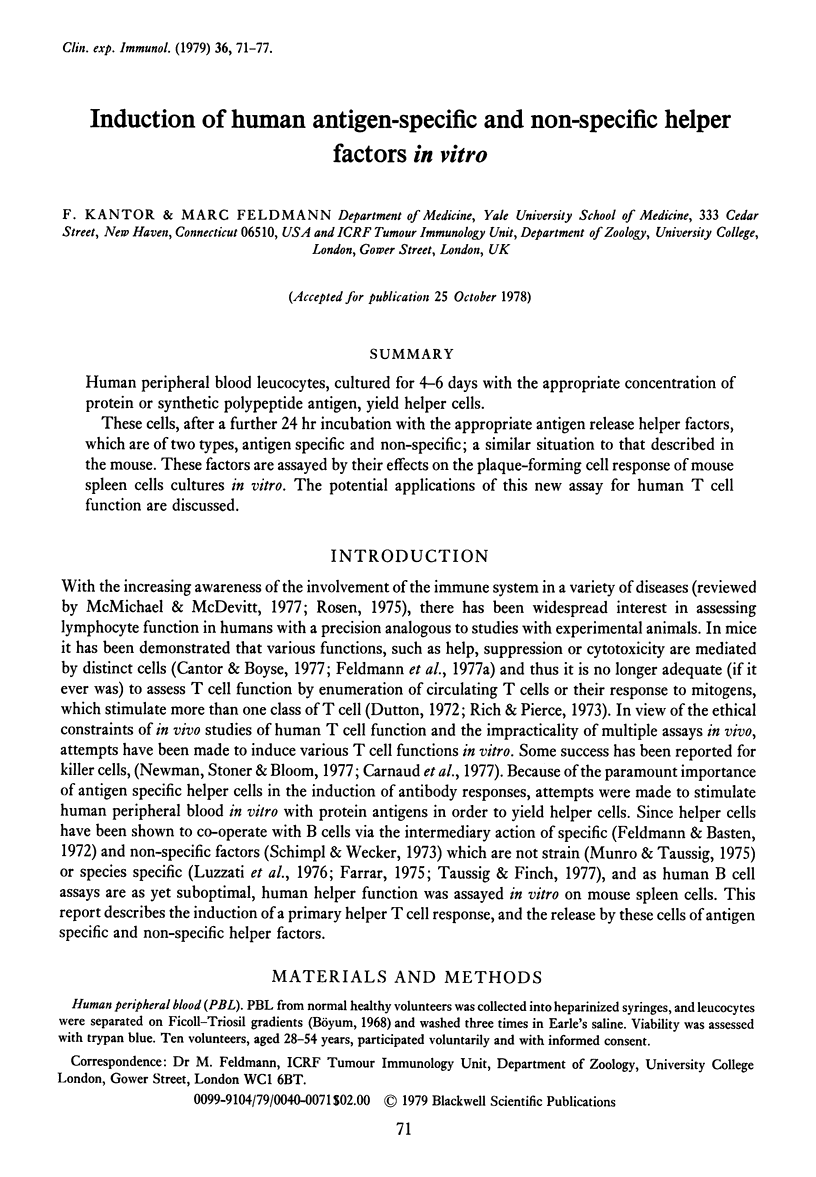
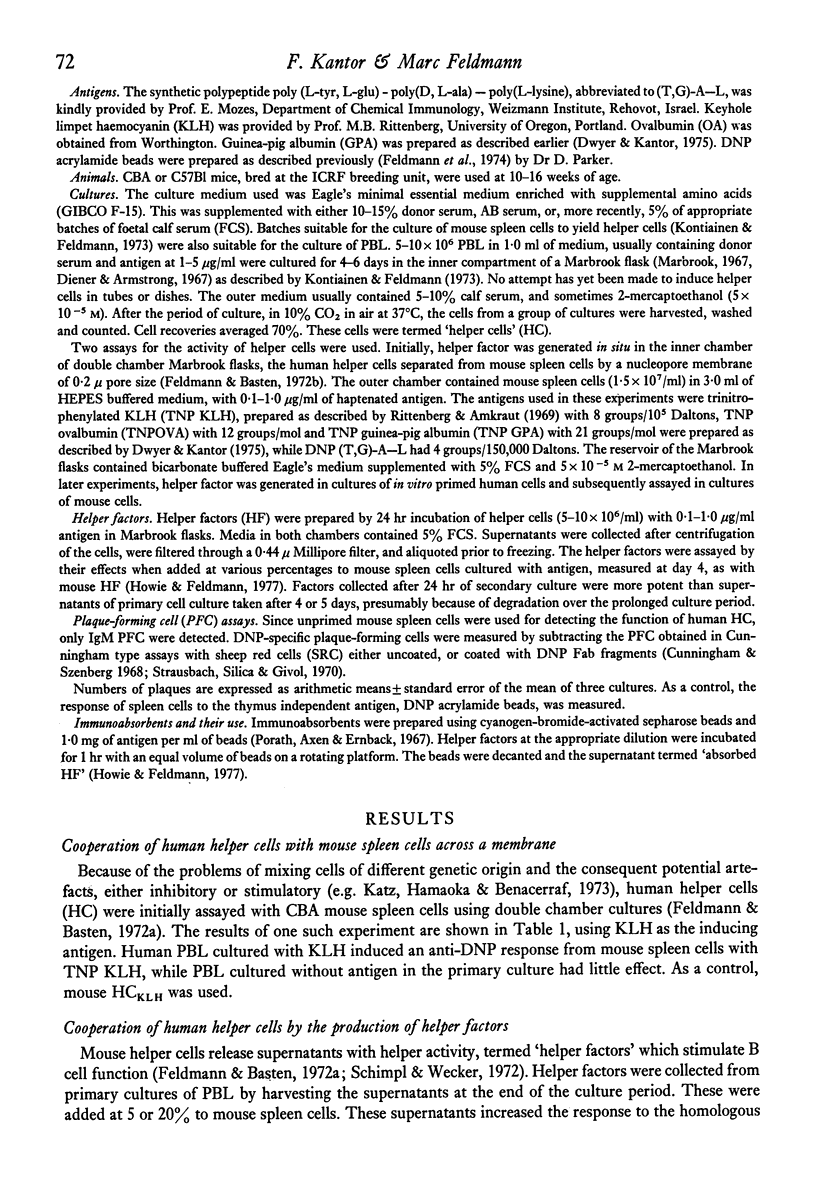
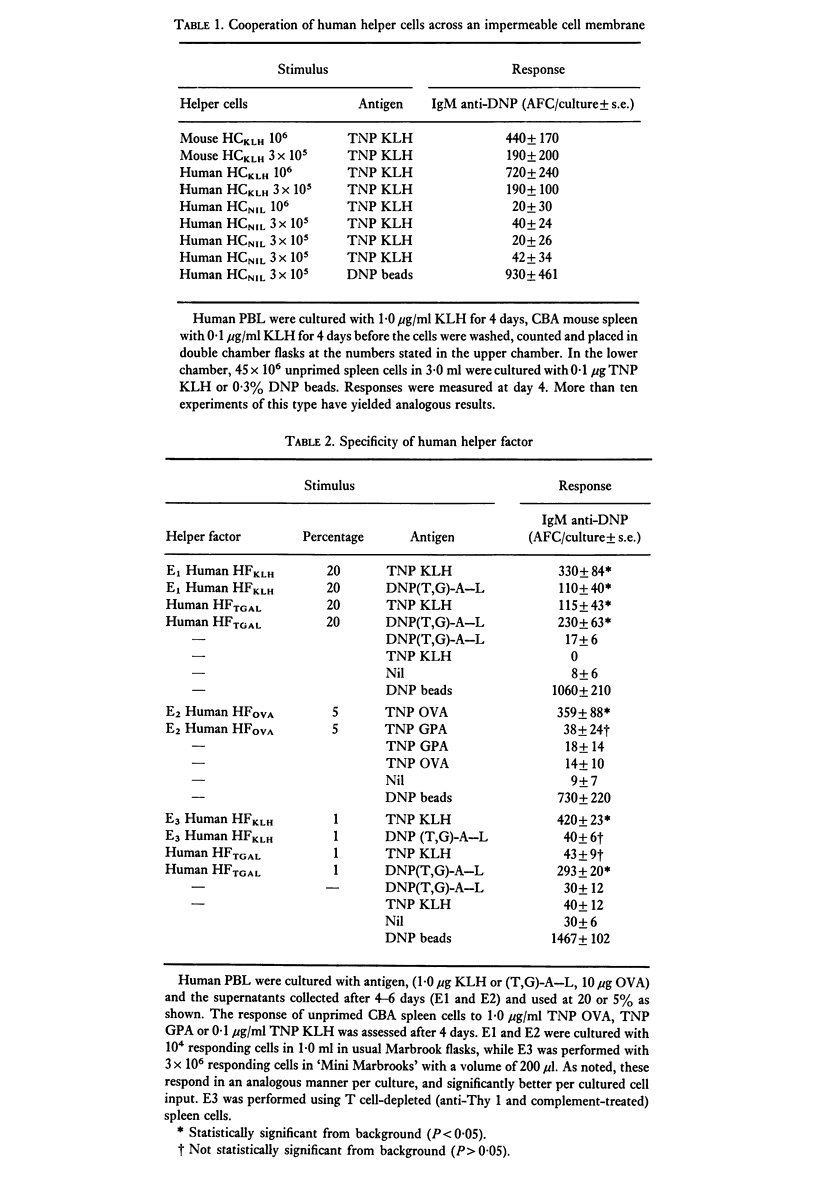
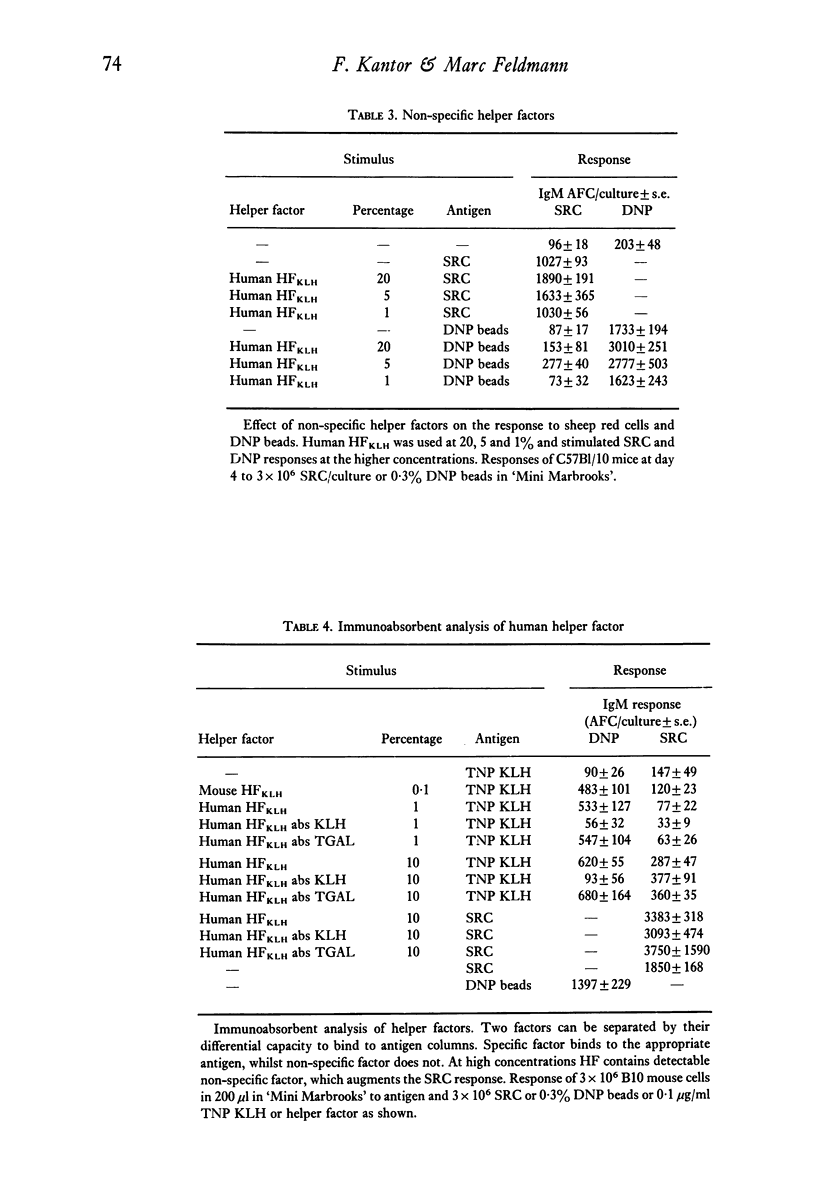
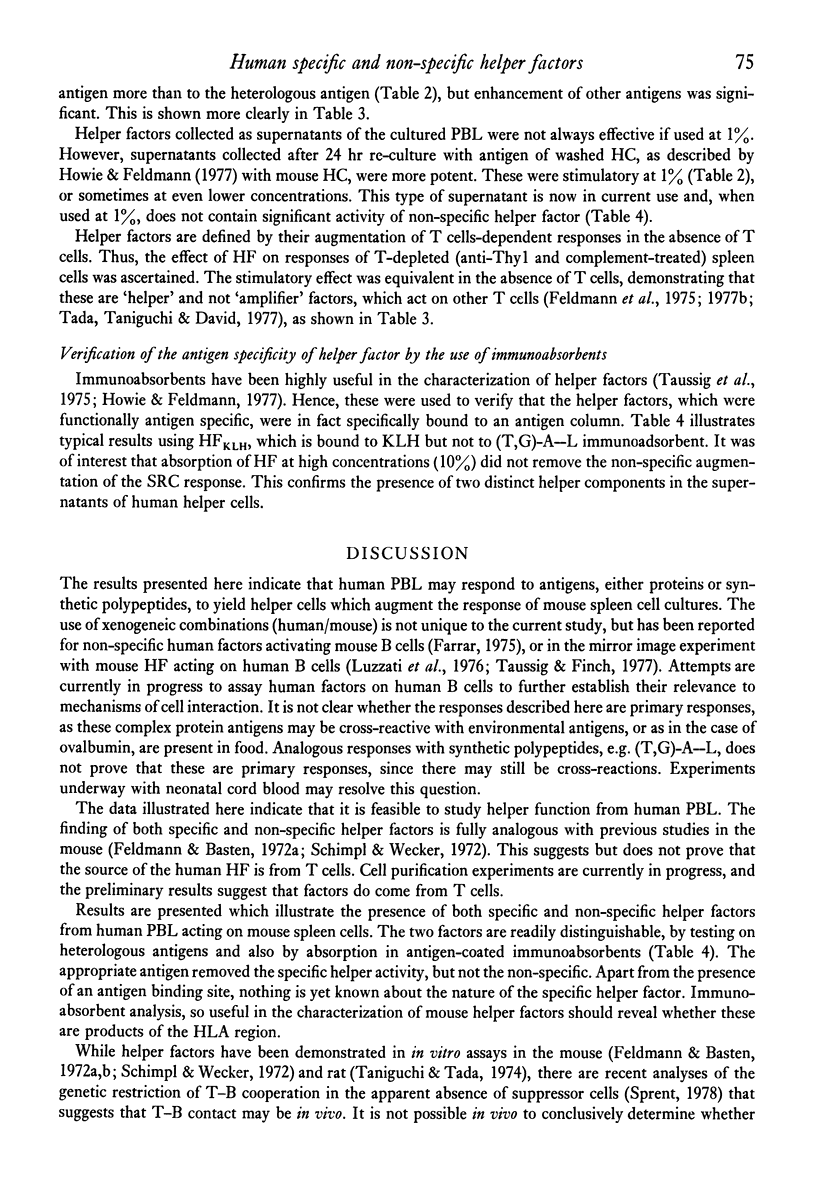
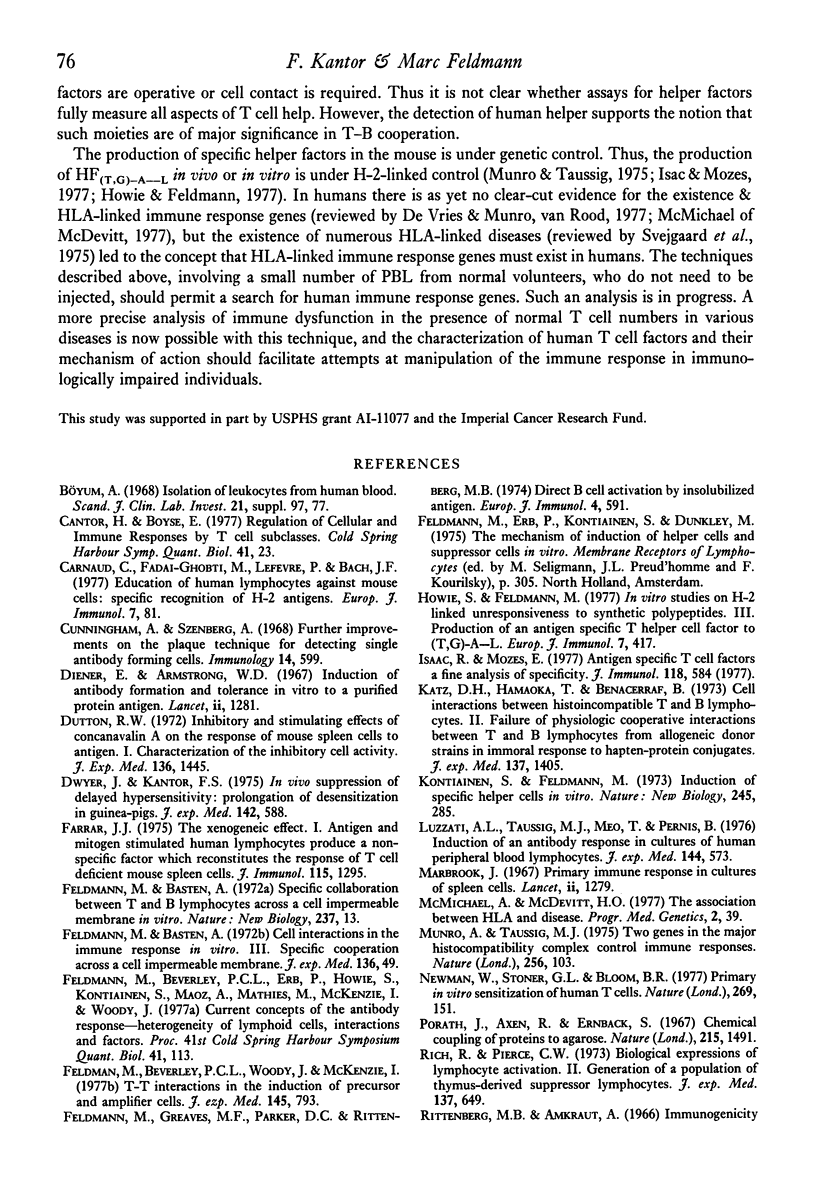
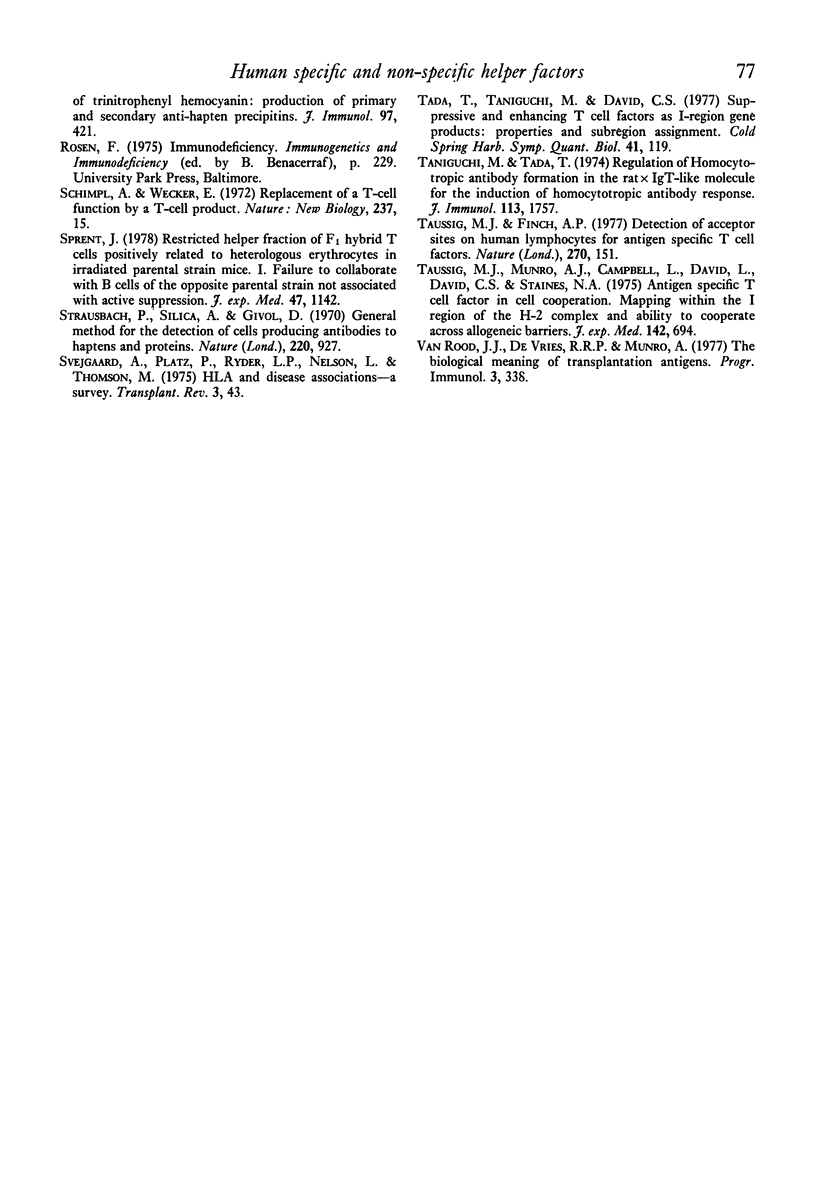
Selected References
These references are in PubMed. This may not be the complete list of references from this article.
- Cantor H., Boyse E. A. Regulation of cellular and humoral immune responses by T-cell subclasses. Cold Spring Harb Symp Quant Biol. 1977;41(Pt 1):23–32. doi: 10.1101/sqb.1977.041.01.006. [DOI] [PubMed] [Google Scholar]
- Carnaud C., Fadaï-Ghotbi M., Lesavre P., Bach J. F. Education of human lymphocytes against mouse cells: specific recognition of H-2 antigens. Eur J Immunol. 1977 Feb;7(2):81–85. doi: 10.1002/eji.1830070206. [DOI] [PubMed] [Google Scholar]
- Cunningham A. J., Szenberg A. Further improvements in the plaque technique for detecting single antibody-forming cells. Immunology. 1968 Apr;14(4):599–600. [PMC free article] [PubMed] [Google Scholar]
- Diener E., Armstrong W. D. Induction of antibody formation and tolerance in vitro to a purified protein antigen. Lancet. 1967 Dec 16;2(7529):1281–1285. doi: 10.1016/s0140-6736(67)90394-7. [DOI] [PubMed] [Google Scholar]
- Dutton R. W. Inhibitory and stimulatory effects of concanavalin A on the response of mouse spleen cell suspensions to antigen. I. Characterization of the inhibitory cell activity. J Exp Med. 1972 Dec 1;136(6):1445–1460. doi: 10.1084/jem.136.6.1445. [DOI] [PMC free article] [PubMed] [Google Scholar]
- Dwyer J. M., Kantor F. S. In vivo suppression of delayed hypersensitivity: prolongation of desensitization in guinea pigs. J Exp Med. 1975 Sep 1;142(3):588–599. doi: 10.1084/jem.142.3.588. [DOI] [PMC free article] [PubMed] [Google Scholar]
- Farrar J. J. The xenogeneic effect. I. Antigen and mitogen-stimulated human lymphocytes produce a non-antigen-specific factor which reconstitutes the antibody response of T cell-deficient mouse spleen cells. J Immunol. 1975 Nov;115(5):1295–1300. [PubMed] [Google Scholar]
- Feldmann M., Basten A. Cell interactions in the immune response in vitro. 3. Specific collaboration across a cell impermeable membrane. J Exp Med. 1972 Jul 1;136(1):49–67. doi: 10.1084/jem.136.1.49. [DOI] [PMC free article] [PubMed] [Google Scholar]
- Feldmann M., Beverley P. C., Woody J., McKenzie I. F. T-T interactions in the induction of suppressor and helper T cells: analysis of membrane phenotype of precursor and amplifier cells. J Exp Med. 1977 Apr 1;145(4):793–801. doi: 10.1084/jem.145.4.793. [DOI] [PMC free article] [PubMed] [Google Scholar]
- Feldmann M., Beverley P., Erb P., Howie S., Kontiainen S., Maoz A., Mathies M., McKenzie I., Woody J. Current concepts of the antibody response: heterogeneity of lymphoid cells, interactions, and factors. Cold Spring Harb Symp Quant Biol. 1977;41(Pt 1):113–118. doi: 10.1101/sqb.1977.041.01.015. [DOI] [PubMed] [Google Scholar]
- Howie S., Feldman M. In vitro studies on H-2-linked unresponsiveness to synthetic polypeptides. III. Production of an antigen-specific T helper cell factor to (T,G)-A--L. Eur J Immunol. 1977 Jul;7(7):417–421. doi: 10.1002/eji.1830070703. [DOI] [PubMed] [Google Scholar]
- Isac R., Mozes E. Antigen-specific T cell factors: a fine analysis of specificity. J Immunol. 1977 Feb;118(2):584–588. [PubMed] [Google Scholar]
- Katz D. H., Hamaoka T., Benacerraf B. Cell interactions between histoincompatible T and B lymphocytes. II. Failure of physiologic cooperative interactions between T and B lymphocytes from allogeneic donor strains in humoral response to hapten-protein conjugates. J Exp Med. 1973 Jun 1;137(6):1405–1418. doi: 10.1084/jem.137.6.1405. [DOI] [PMC free article] [PubMed] [Google Scholar]
- Kontianen S., Feldmann M. Induction of specific helper cells in vitro. Nat New Biol. 1973 Oct 31;245(148):285–286. doi: 10.1038/newbio245285a0. [DOI] [PubMed] [Google Scholar]
- Luzzati A. L., Taussig M. J., Meo T., Pernis B. Induction of an antibody response in cultures of human peripheral blood lymphocytes. J Exp Med. 1976 Sep 1;144(3):573–585. doi: 10.1084/jem.144.3.573. [DOI] [PMC free article] [PubMed] [Google Scholar]
- Marbrook J. Primary immune response in cultures of spleen cells. Lancet. 1967 Dec 16;2(7529):1279–1281. doi: 10.1016/s0140-6736(67)90393-5. [DOI] [PubMed] [Google Scholar]
- McMichael A., McDevitt H. The association between the HLA system and disease. Prog Med Genet. 1977;2:39–100. [PubMed] [Google Scholar]
- Munro A. J., Taussig M. J. Two genes in the major histocompatibility complex control immune response. Nature. 1975 Jul 10;256(5513):103–106. doi: 10.1038/256103a0. [DOI] [PMC free article] [PubMed] [Google Scholar]
- Newman W., Stoner G. L., Bloom B. R. Primary in vitro sensitisation of human T cells. Nature. 1977 Sep 8;269(5624):151–153. doi: 10.1038/269151a0. [DOI] [PubMed] [Google Scholar]
- Porath J., Axen R., Ernback S. Chemical coupling of proteins to agarose. Nature. 1967 Sep 30;215(5109):1491–1492. doi: 10.1038/2151491a0. [DOI] [PubMed] [Google Scholar]
- Rich R. R., Pierce C. W. Biological expressions of lymphocyte activation. II. Generation of a population of thymus-derived suppressor lymphocytes. J Exp Med. 1973 Mar 1;137(3):649–659. doi: 10.1084/jem.137.3.649. [DOI] [PMC free article] [PubMed] [Google Scholar]
- Rittenberg M. B., Amkraut A. A. Immunogenicity of trinitrophenyl-hemocyanin: production of primary and secondary anti-hapten precipitins. J Immunol. 1966 Sep;97(3):421–430. [PubMed] [Google Scholar]
- Sprent J. Restricted helper function of F1 hybrid T cells positively selected to heterologous erythrocytes in irradiated parental strain mice. I. Failure to collaborate with B cells of the opposite parental strain not associated with active suppression. J Exp Med. 1978 Apr 1;147(4):1142–1158. doi: 10.1084/jem.147.4.1142. [DOI] [PMC free article] [PubMed] [Google Scholar]
- Svejgaard A., Platz P., Ryder L. P., Nielsen L. S., Thomsen M. HL-A and disease associations--a survey. Transplant Rev. 1975;22:3–43. doi: 10.1111/j.1600-065x.1975.tb01550.x. [DOI] [PubMed] [Google Scholar]
- Tada T., Taniguchi M., David C. S. Suppressive and enhancing T-cell factors as I-region gene products: properties and the subregion assignment. Cold Spring Harb Symp Quant Biol. 1977;41(Pt 1):119–127. doi: 10.1101/sqb.1977.041.01.016. [DOI] [PubMed] [Google Scholar]
- Taniguchi M., Tada T. Regulation of homocytotropic antibody formation in the rat. X. IgT-like molecule for the induction of homocytotropic antibody response. J Immunol. 1974 Dec;113(6):1757–1769. [PubMed] [Google Scholar]
- Taussig M. J., Finch A. P. Detection of acceptor sites on human lymphocytes for antigen-specific T cell factors. Nature. 1977 Nov 10;270(5633):151–154. doi: 10.1038/270151a0. [DOI] [PubMed] [Google Scholar]
- Taussig M. J., Munro A. J., Campbell R., David C. S., Staines N. A. Antigen-specific T-cell factor in cell cooperation. Mapping within the I region of the H-2 complex and ability to cooperate across allogeneic barriers. J Exp Med. 1975 Sep 1;142(3):694–700. doi: 10.1084/jem.142.3.694. [DOI] [PMC free article] [PubMed] [Google Scholar]


